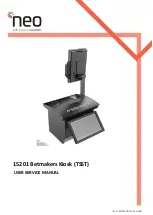
9
Introduction
•
Intended Audience
This manual is intended for the following personnel, who must also have knowledge of
electrical systems (an electrical engineer or the equivalent).
•
Personnel in charge of introducing FA systems into production facilities.
•
Personnel in charge of designing FA systems.
•
Personnel in charge of installing and connecting FA systems.
•
Personnel in charge of managing FA systems and facilities.
•
General Precautions
•
The user must operate the product according to the performance specifications
described in the operation manuals.
•
Do not use the PT touch switch input functions for applications where danger to human
life or serious property damage is possible, or for emergency switch applications.
•
Before using the product under conditions which are not described in the manual or
applying the product to nuclear control systems, railroad systems, aviation systems,
vehicles, combustion systems, medical equipment, amusement machines, safety
equipment, and other systems, machines and equipment that may have a serious
influence on lives and property if used improperly, consult your OMRON representative.
•
Make sure that the ratings and performance characteristics of the product are sufficient
for the systems, machines, and equipment, and be sure to provide the systems,
machines, and equipment with double safety mechanisms.
•
This manual provides information for connecting and setting up an NS-series PT. Be
sure to read this manual before attempting to use the PT and keep this manual close at
hand for reference during installation and operation.
•
Safety Precautions
Do not attempt to take the Unit apart and do not
touch any internal parts while the power is being
supplied. Doing either of these may result in
electrical shock.
•
Operating Environment Precautions
1. Do not install the Unit in the following places:
•
Locations subject to direct sunlight
•
Locations subject to temperatures or humidity outside the range specified in the
specifications
•
Locations subject to condensation as the result of severe changes in temperature
•
Locations subject to corrosive or flammable gases
•
Locations subject to dust (especially iron dust) or salts
•
Locations subject to exposure to water, oil, or chemicals
•
Locations subject to shock or vibration








































